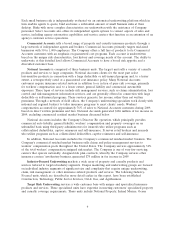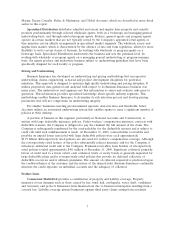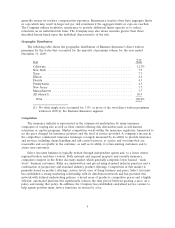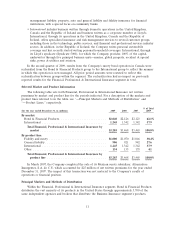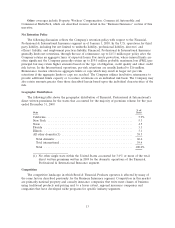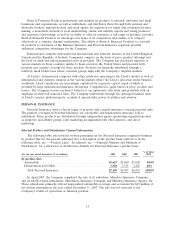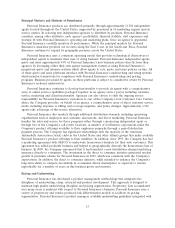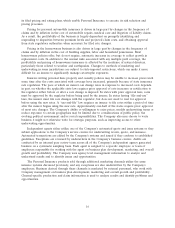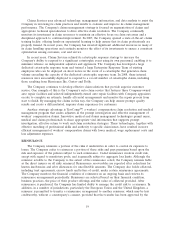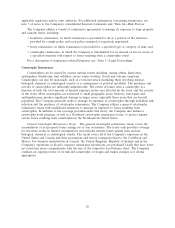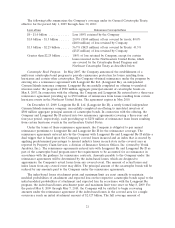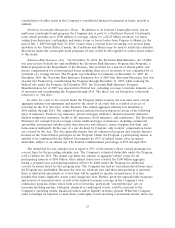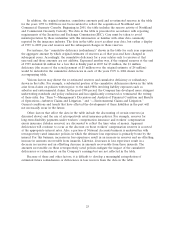Travelers 2009 Annual Report Download - page 27
Download and view the complete annual report
Please find page 27 of the 2009 Travelers annual report below. You can navigate through the pages in the report by either clicking on the pages listed below, or by using the keyword search tool below to find specific information within the annual report.Principal Markets and Methods of Distribution
Personal Insurance products are distributed primarily through approximately 11,500 independent
agents located throughout the United States, supported by personnel in 16 marketing regions and six
service centers. In selecting new independent agencies to distribute its products, Personal Insurance
considers, among other attributes, each agency’s profitability, financial stability, staff experience and
strategic fit with Personal Insurance’s operating and marketing plans. Once an agency is appointed,
Personal Insurance carefully monitors its performance. While the principal markets for Personal
Insurance’s insurance products are in states along the East Coast, in the South and Texas, Personal
Insurance continues to expand its geographic presence across the United States.
Personal Insurance uses a consistent operating model that provides technological alternatives to
independent agents to maximize their ease of doing business. Personal Insurance independent agents
quote and issue approximately 94% of Personal Insurance’s new business policies directly from their
agencies by leveraging either their own agency management system or using Personal Insurance’s
proprietary quote and issuance systems which allow agents to rate, quote and issue policies on line. All
of these quote and issue platforms interface with Personal Insurance’s underwriting and rating systems,
which monitor transactions for compliance with Personal Insurance’s underwriting and pricing
programs. Business processed by agents on these platforms is subject to consultative review by Personal
Insurance’s in-house underwriters.
Personal Insurance continues to develop functionality to provide its agents with a comprehensive
array of online service capabilities packaged together in an agency service portal, including customer
service, marketing and claim functionality. Agencies can also choose to shift the ongoing service
responsibility for Personal Insurance’s customers to one of the Company’s four Customer Care Centers,
where the Company provides, on behalf of an agency, a comprehensive array of direct customer service
needs, including response to billing and coverage inquiries, and policy changes. Approximately 1,540
agents take advantage of this service alternative.
Personal Insurance also markets through additional distribution channels, including sponsoring
organizations such as employers and consumer associations, and direct marketing. Personal Insurance
handles the sales and service for these programs either through a sponsoring independent agent or
through two of the Company’s call center locations. A number of well-known corporations make the
Company’s product offerings available to their employees primarily through a payroll deduction
payment process. The Company has significant relationships with the majority of the American
Automobile Association (AAA) clubs in the United States and other affinity groups that make available
Personal Insurance’s product offerings to their members. In addition, since 1995, the Company has had
a marketing agreement with GEICO to underwrite homeowners business for their auto customers. This
agreement has added profitable business and helped to geographically diversify the homeowners line of
business. In 2009, the Company announced that it had launched a new distribution channel marketing
insurance directly to consumers. The investment in the direct to consumer initiative generated modest
growth in premium volume for Personal Insurance in 2009, which was consistent with the Company’s
expectations. In addition, the direct to consumer initiative, while intended to enhance the Company’s
long-term ability to compete successfully in a consumer-driven marketplace, is expected to remain
unprofitable for a number of years as this business grows and matures.
Pricing and Underwriting
Personal Insurance has developed a product management methodology that integrates the
disciplines of underwriting, claim, actuarial and product development. This approach is designed to
maintain high quality underwriting discipline and pricing segmentation. Proprietary data accumulated
over many years is analyzed with respect to Personal Insurance’s business. Personal Insurance uses a
variety of proprietary and vendor produced risk differentiation models to facilitate its pricing
segmentation. Personal Insurance’s product managers establish underwriting guidelines integrated with
15



